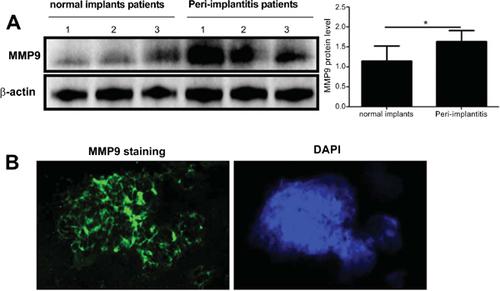Current Pharmaceutical Biotechnology ( IF 2.8 ) Pub Date : 2020-06-30 , DOI: 10.2174/1389201021666200221121139 Qian Zhang 1 , Haitao Xu 1 , Na Bai 1 , Fei Tan 1 , Huirong Xu 2 , Jie Liu 1

|
Background and Objective: Dental peri-implantitis, which can be caused by several different microbial factors, is characterized by inflammatory lesions of the surrounding hard and soft tissues of an oral implant. Matrix Metalloproteinase 9 (MMP9) is thought to be involved in the pathogenesis of peri-implantitis. However, the regulatory mechanism of MMP9 in peri-implantitis has not been fully elucidated. In this study, we tried to evaluate the regulatory mechanism of MMP9 in peri-implantitis.
Methods: We collected Peri-Implant Crevicular Fluid (PICF) from ten healthy implants and ten periimplantitis patients and compared their expression level of MMP9. We also cultured macrophages from the peripheral blood of healthy volunteers infected by Porphyromonas gingivalis to reveal the regulatory mechanism of MMP9 in peri-implantitis. Western blot, immunofluorescence staining and quantitative Polymerase Chain Reaction (RT-PCR) were used to better characterize the mechanism of MMP9.
Results: The expression of MMP9 was up-regulated in peri-implantitis patient PICF and P. gingivalis infected human macrophages. LOX-1, not dectin-1, was found to mediate MMP9 expression in human macrophages with P. gingivalis infection. Expression of Erk1/2 was responsible for infection-induced MMP9 expression. Finally, use of a broad-spectrum metalloproteinase inhibitor impaired LOX-1 expression in infected macrophages.
Conclusion: Our results demonstrate that MMP9 is involved in dental peri-implantitis and is regulated by LOX-1 and Erk1/2. This LOX-1/MMP9 signaling pathway may represent a potential drug target for peri-implantitis.
中文翻译:

基质金属蛋白酶9受LOX-1和erk1 / 2途径调控的牙周种植体炎。
背景与目的:牙周种植体炎可能是由几种不同的微生物因素引起的,其特征是口腔植入物周围的硬组织和软组织出现炎症性病变。基质金属蛋白酶9(MMP9)被认为与种植体周围炎的发病机理有关。但是,MMP9在种植体周围炎中的调控机制尚未完全阐明。在这项研究中,我们试图评估MMP9在种植体周围炎中的调节机制。
方法:我们从10例健康植入物和10例植入物周围炎患者中收集了植入物周围沟液(PICF),并比较了它们的MMP9表达水平。我们还从牙龈卟啉单胞菌感染的健康志愿者的外周血中培养了巨噬细胞,以揭示MMP9在种植体周围炎中的调控机制。Western blot,免疫荧光染色和定量聚合酶链反应(RT-PCR)被用来更好地表征MMP9的机制。
结果:植入物周围炎患者PICF和牙龈卟啉单胞菌感染的人类巨噬细胞中MMP9的表达上调。发现LOX-1,而不是dectin-1,介导了牙龈卟啉单胞菌感染的人类巨噬细胞中MMP9的表达。Erk1 / 2的表达负责感染诱导的MMP9表达。最后,使用广谱金属蛋白酶抑制剂会损害巨噬细胞中LOX-1的表达。
结论:我们的结果表明MMP9参与牙种植体周围炎,并受LOX-1和Erk1 / 2的调节。该LOX-1 / MMP9信号通路可能代表植入物周围炎的潜在药物靶标。



























 京公网安备 11010802027423号
京公网安备 11010802027423号